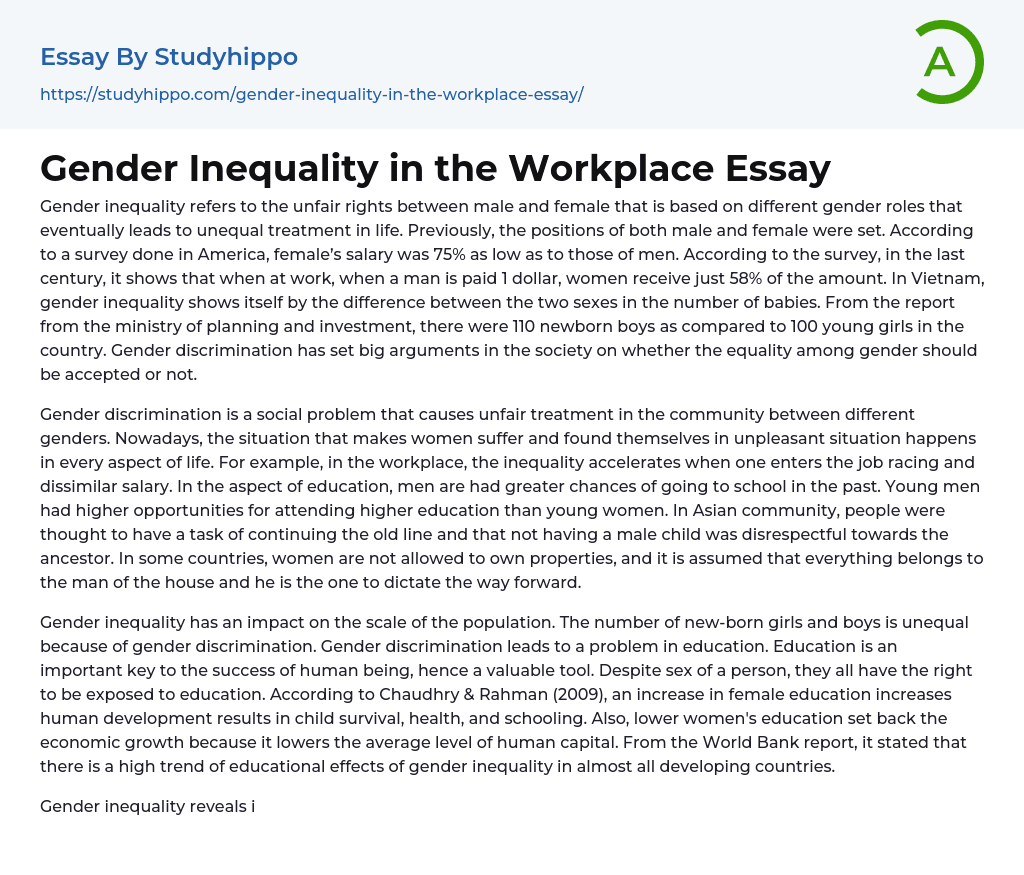Gender inequality refers to the unfair rights between male and female that is based on different gender roles that eventually leads to unequal treatment in life. Previously, the positions of both male and female were set. According to a survey done in America, female’s salary was 75% as low as to those of men. According to the survey, in the last century, it shows that when at work, when a man is paid 1 dollar, women receive just 58% of the amount. In Vietnam, gender inequality shows itself by the difference between the two sexes in the number of babies. From the report from the ministry of planning and investment, there were 110 newborn boys as compared to 100 young girls in the country. Gender discrimination has set big arguments in the society on whether the equality among gender should be accepted or
...not.
Gender discrimination is a social problem that causes unfair treatment in the community between different genders. Nowadays, the situation that makes women suffer and found themselves in unpleasant situation happens in every aspect of life. For example, in the workplace, the inequality accelerates when one enters the job racing and dissimilar salary. In the aspect of education, men are had greater chances of going to school in the past. Young men had higher opportunities for attending higher education than young women. In Asian community, people were thought to have a task of continuing the old line and that not having a male child was disrespectful towards the ancestor. In some countries, women are not allowed to own properties, and it is assumed that everything belongs to the man of the house an
he is the one to dictate the way forward.
Gender inequality has an impact on the scale of the population. The number of new-born girls and boys is unequal because of gender discrimination. Gender discrimination leads to a problem in education. Education is an important key to the success of human being, hence a valuable tool. Despite sex of a person, they all have the right to be exposed to education. According to Chaudhry & Rahman (2009), an increase in female education increases human development results in child survival, health, and schooling. Also, lower women's education set back the economic growth because it lowers the average level of human capital. From the World Bank report, it stated that there is a high trend of educational effects of gender inequality in almost all developing countries.
Gender inequality reveals itself when there is the lack of representation of women. This means that women have become the shock absorbers of austerity. Women find themselves earning less than their male counterparts despite being in the same job group and paying far much higher prices in some of the occasions and situations. Women are now fighting to end the inequality. However, women are still looked down upon in the society, and still, men have power. Not many people believe that women can hold high-powered positions in the society. Many men believe that women are not that aggressive and strong enough to handle positions that come with high pressure. There is a believe that women are better off in taking the traditional gender role of staying at home and take care of the family and households. In many homes, the research shows that
men perform only 20 to 30 percent of the housework.
Karl Marx believed that social change in the society is the natural order. In each situation in the society, he mentioned that there are those people who control property and those who work. He mentioned that in the capitalist society, based on the production of goods, there are those who own the production, knowledge, property and wealth. On the other hand, there are those who own nothing and make their living working, thereby supplying labor to the capitalist. Concerning the inequality in the society, he expressed his views while discussing the Victorian culture and the current culture that is socially and technological rather different. In gender discrimination, Karl Marx tried explained about the origin of women oppression, and he pointed out that the inequality at one point did not exist and explained how to end the inequality in the society by looking at it towards a future society where it will be something of the past (Levine, 2006). In gender inequality, he was concerned on how the monogamy was developed. He explained on by identifying the role of each in the family and identifies who controls the children in any particular society.
Towards the current trend of gender discrimination, regarding power sharing, as he was a feminist, would have disagreed with the current situation in many of the offices where men dominate majority of the top positions because he was on the move to see the equality on roles played between a man and a woman. From the issue of wage payment, women are being paid less as compared to men on the same job level, and he
would have appealed. Women being like men, can act and perform as men so no need of discrimination against payment and people of the same level irrespective of their sex, should be equally paid out.
References
- Chaudhry, I. S., & Rahman, S. (2009). The impact of gender inequality in education on rural poverty in Pakistan: an empirical analysis. European Journal of Economics, Finance and Administrative Sciences, 15(1), 174-188.
- Levine, R. F. (2006). Social class and stratification: Classic statements and theoretical debates. Lanham: Rowman & Littlefield Pub.
Bottom of Form




